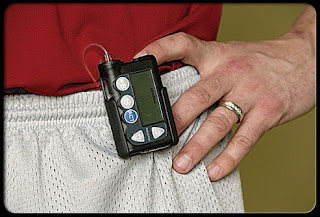my positive point for my life is.....To be hopeful in bad times is not just foolishly romantic. It

my positive point for my life is.....To be hopeful in bad times is not just foolishly romantic. It is based on the fact that human history is a history not only of cruelty, but also of compassion, sacrifice, courage, kindness. What we choose to emphasize in this complex history will determine our lives. If we see only the worst, it destroys our capacity to do something. If we remember those times and places -- and there are so many -- where people have behaved magnificently, this gives us the energy to act, and at least the possibility of sending this spinning top of a world in a different direction.
Thursday, March 29, 2012
Diabetes Treatment: Insulin Shots
Diabetes Treatment: Insulin Shots
Everyone with type 1 diabetes must take insulin to help the body process blood sugar. Most patients take insulin as an injection and need multiple shots per day. Your healthcare provider will explain how to adjust your insulin shots based on the results of your blood sugar testing. The goal is to keep glucose levels in the normal range as often as possible.
Insulin Reaction Warning Signs
Taking too much insulin can lower your blood sugar to dangerous levels. This is called an insulin reaction. These reactions can be mild, moderate, or severe, requiring the help of others. Warning signs include:
Exhaustion or excessive yawning
Being unable to speak or think clearly
Loss of muscle coordination
Sweating, twitching, turning pale
Seizures
Loss of consciousness
Neutralizing an Insulin Reaction
People who take insulin should carry at least 15 grams of a quick-acting carb at all times. Fast carbs are a way to bring the blood sugar up quickly to combat an insulin reaction. Examples include:
1/2 cup of fruit juice or non-diet soda
1 cup of milk
2 tablespoons of raisins
3 glucose tablets or 5 Lifesavers
If your blood sugar is still too low after 15 minutes, have another 15 grams. For a severe reaction, a drug called glucagon should be injected under the skin by a family member.
Diabetes Treatment: Insulin Pump
One way to reduce the odds of an insulin reaction is to use an insulin pump. This device provides insulin through a tiny tube inserted into the skin. It delivers insulin around the clock, eliminating the need for insulin shots. An insulin pump can help keep your blood sugar more stable and may allow more flexibility in planning your meals. Insulin pumps do have some disadvantages, so talk to your doctor to learn if this option is right for you.
How Well Is Your Treatment Working?
To find out how well your treatment is working, your doctor will probably suggest you have an A1c blood test every three to six months. This test reveals how well your blood sugar has been controlled over the past two to three months. If the results show poor blood sugar control, you may need to adjust your insulin therapy, meal planning, or physical activity.
How Well Is Your Treatment Working?
To find out how well your treatment is working, your doctor will probably suggest you have an A1c blood test every three to six months. This test reveals how well your blood sugar has been controlled over the past two to three months. If the results show poor blood sugar control, you may need to adjust your insulin therapy, meal planning, or physical activity.
Subscribe to:
Post Comments (Atom)







No comments:
Post a Comment